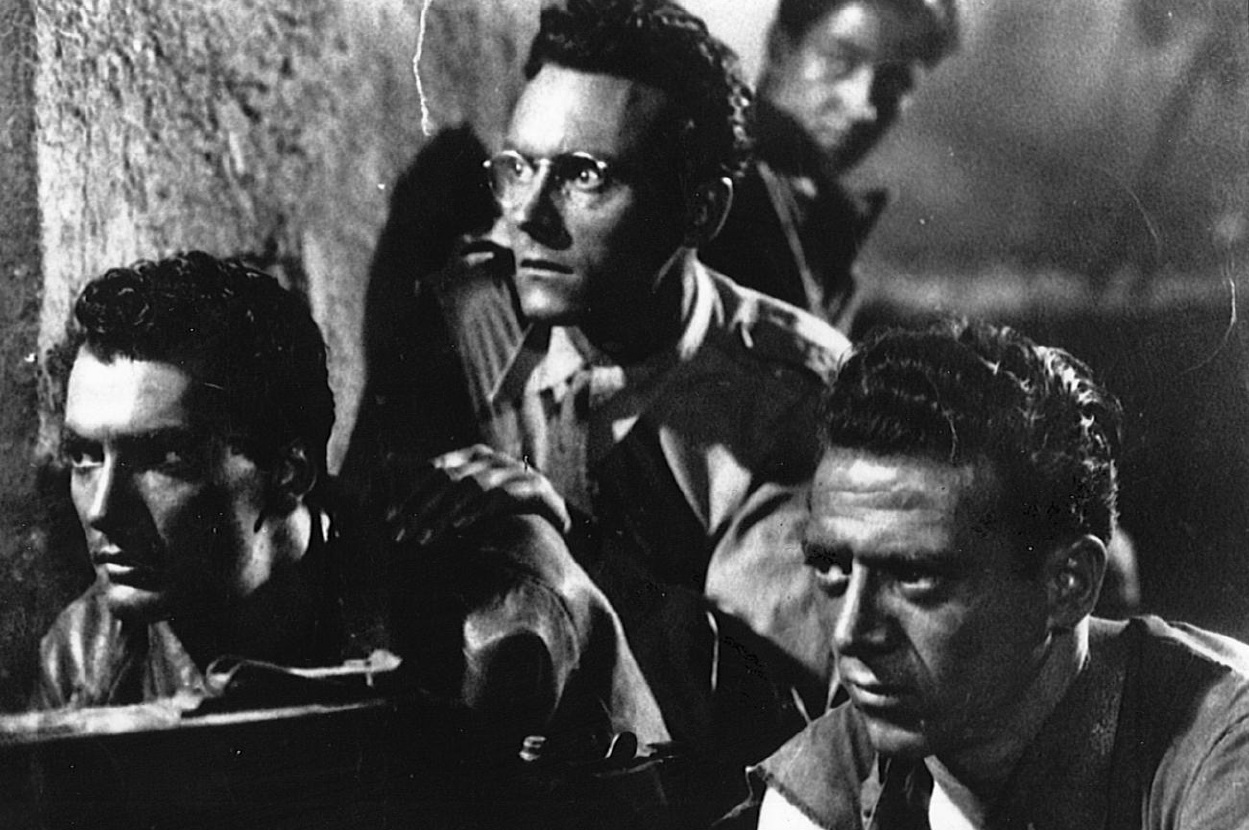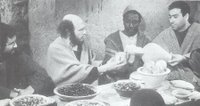L'uomo dalla croce (1943)

Back in 2014 I wrote a chapter for the book "The Bible in Motion" on the films of Roberto Rossellini. One of the biggest challenges in writing the chapter was tracking down enough of his films to be able to discuss. Since then the BFI and Criterion have released a number of his works, but there was one title in particular that I was disappointed not to be able to see as it sounded like it might be of some relevance: L'uomo dalla croce (The Man of the Cross, 1943).
The film was only Rossellini's third feature and came during what is often called his fascist period. For most of its existence Italian fascism was somewhat different from what was happening with the Nazis in Germany, such that communists, anti-fascists and fascists could mix without too much fear of reprisal.
Rossellini, himself never hugely political, was good friends with Vittorio Mussolini, son of Il Duce, indeed it was he who got him his big break into filmmaking. In later years, Rossellini was understandably keen to distance himself from his involvement with the fascists and there's precious little evidence to suggest he was took on their beliefs, even if he was closer to the dictator's son than either he, or many of his admirers care to discuss.
His films from this period, however, contain a surprising degree of ambiguity around their connection with fascism. Tag Gallagher, in his fine biography of Rossellini highlights the many ways that the three films he made at that time subvert expectations. Indeed he makes the point that it is hard to imagine an American film from that period including such criticisms of the military. Not everyone agrees, Peter Bondanella argues that some Rossellini scholars are a little too keen to read into these films subversive messages. I assume he's thinking of Gallagher, but have not read enough about the subject to know for certain.
Rossellini's two previous films La nave bianca (The White Boat, 1941) and La pilota ritorna (The Pilot Returns, 1942) had dealt with the navy and the air force respectively, so naturally the final instalment deals with the army. The story revolves around the Italian insurgence into Russian territory, but the film's was delayed for so long that by the time it was released the Italian army was very much on the back foot in chaotic conditions. The "man" of the title is Father Reginaldo Giuliani, an army chaplain, who stays behind in no-mans-land between the two warring armies to look after an injured soldier. The majority of the film takes place in a crowded, ramshackle cottage where the Italians mix with Russian peasants, themselves equally trapped.
As with the other two films in this trilogy, Rossellini includes elements that may well have not made it into and English or American movies from the same era. For example, it's difficult to think of a film by the allies where they show injured men being left behind at anything other than the victim's insistence, yet here it is the central element of the plot. Anyone seeking an unlikely double bill with Mel Gibson's Hacksaw Ridge (2017) need look no further.
The brief behind my previous piece on Rossellini was to cover how he treated the Bible, and it took a slightly broader course than simply re-hashing my writing on Atti degli apostoli (Acts of the Apostles, 1969) and Il Messia (The Messiah, 1975), covering how relevant parts of films, even such as his biopic Blaise Pascal (1972), touched on the Bible. This film certainly touches on issue of faith and the Bible as much as Pascal, if not slightly more.
There are various moments that stand out in this respect. At one point, stuck in a bombed out cottage with a potent mixture of Italians and Russians, Giuliani refuses to treat the later any differently from how he would treat his compatriots. "I am a minister of God who is the Father of all men and even if they are hostile they are all brothers in his eyes" he argues at one point.
More to the point, however, is that Giuliani sees his role as a comforter, not least because there's a suggestion that God's salvation is already present for those who pursue it. Moments after Sergei, one of the leading Russians, dies, Father Giuliani comforts his partner Irina, urging her not to give up hope so they will be reunited, with the words:
"And God will tell you. And God will urge you. But if he was a man with goodness in his soul, then he is never truly gone. Before you give up you must shout, and you must plead with him. The Lord is always listening to you, up there in heaven. The Lord, who died on the cross for you, for your Sergei. Sergei, Sergei...God says to you: 'Bless those who cry for they must be consoled'"Of course part of this portrayal is also propaganda. Italy hosts the headquarters of the Roman Catholic church, the faith of its army is a central point that contrasts strongly with the atheism that was the policy of the Russian state at the time. Indeed the opening credits of the film dedicate it to "the heroic chaplains fallen among the Godless in barbaric lands".
But perhaps the film's most memorable "biblical" moment - and I don't want to just reduce the film to that, as it's certainly about far more - is the birth of Sergei and Irina's child. It's here that the film's humble setting comes into it's own: the rural context means that animals are in the background, and hay abounds in the misè-en-scene all give this the feel of a certain stable in Bethlehem and the composition of Irina holding her child further reinforce the point. Moments later Giuliani gives the child a Christian baptism, just one of many examples of him performing the function of a priest amongst his people. The child is baptised with the name of Nicola, with its connotations of St Nicholas, who as well as his connection to the birth of Jesus is also the patron saint of Russia.
As much as the film nicely covers the essential bases of priesthood in the most unlikely of contexts - under fire in a remote part of atheist Russia, it never really gets beneath Giulliani's skin in the way later films do. To quote Tag Gallagher, by this early stage in his career "Rossellini is not yet a moviemaker with real people. His priest is an outline, his other characters bare figures in the chorus." (Gallagher, 105). In some ways it is that old problem of portraying goodness being far harder than portraying evil. Giulliani is more or less faultless even as he dies he crawls across the floor to whisper the words of the Lord's Prayer into his assassin's ear. He is far from the tormented ministers of Bergman's faith trilogy, or from a variety of movie priests who have struggled with their consciences.
Even with that said there is more to the portrayal of goodness than that. Three years later Rossellini's Roma, città aperta would revisit the heroic priest character, who similarly lacked the flaws of other movie ministers. Yet there, in the character of Don Pietro Pellegrini, Rossellini fashions a character of real depth as well as real goodness. In many ways Giulliani is his forerunner; the connection between the two is plain to see.
Having said all that, the film is not without its masterful moments. In particular, Rossellini shows his skill at recreating what looks like documentary footage. The battle scenes are particularly effective in this respect. There's something about them that I can't quite put my finger on that makes them seem so much more real than other war-action scenes, yet they are all dramatic reconstructions. Particularly striking in this respect is the shots of the Italian infantry moving in with their fire hoses ablaze. Even if Rossellini was not the finished article by this stage, his mastery of these scenes is already apparent and it was not long before his command of dialogue and social interaction would catch up.
=========
Gallagher, Tag (1998) The Adventures of Roberto Rossellini: His Life and Films New York: Da Capo Press.
Labels: Other Films, Rossellini


































